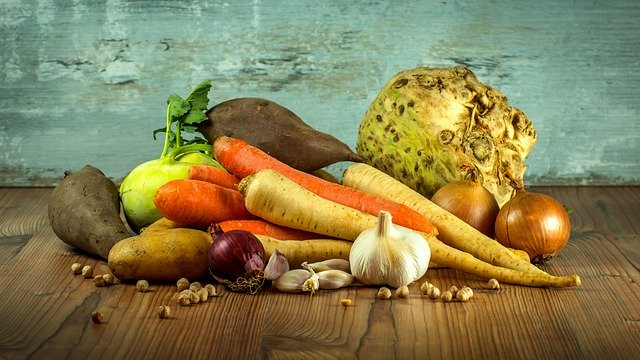Many vegetable crops were domesticated several centuries ago.
The great ancient civilization in Mesopotamia grew vegetables such as turnips, onions, beans, lettuce, and cucumbers.
While the early Egyptians cultivated a wide variety of vegetable crops such as asparagus, cabbage, cucumber, pear, watermelon, and lettuce.
Laborers eating onions were depicted in Egyptian tombs from about 3200-2780 BC.
Early evidence of vegetable cultivation in the new world dates from 7000 to 5000 B.C.
There, the native vegetables were kidney and Lima beans, peppers, gourds, tomato, potato, and pumpkins.
Crops may have been among the earliest to be domesticated in the humid tropics, preceding the cultivation of seed crops.
Vegetable growing is one of the major enterprises of horticulture.
There is no satisfactory definition for the word ‘vegetable’.
In a popular sense, the term vegetable applies to those plants or plant parts that are usually eaten fresh or cooked with the main course of a meal or used for dessert and salads.
Classification
Vegetables have been classified into several groups and there are four general criteria of classification
- Botanical
- Hardiness
- Cultural methods and
- Parts of the plant used for food
For the sake of convenience, the last method of classification will be used as follows:
- Plants grown mainly for their leaves and shoots are referred to as herbage or leafy vegetables. Examples include amaranths, Celosia argentea, waterleaf, bitter leaf, lettuce, etc.
- Plants grown mainly for their vegetable and condiment fruits are referred to as fruit vegetables. These include tomato, cucumber, pepper, okra, eggplant, etc.
- Plants grown mainly for their roots are referred to as earth vegetables or root crops. These include Irish potatoes, sweet potatoes, carrot, beetroot, etc.
- Plants were grown mainly for their buds, e.g. Brussels sprouts.
- Plants were grown mainly for their bulbs, e.g.Onion, and garlic
- Plants were grown mainly for their flower stalk and buds e.g Cauliflower.
- Plants were grown mainly for their seeds, e.g beans, peas, and melon.
Categories one to four include many tropical vegetables which will be considered in this section.
Categories five to seven comprise vegetables of temperate and subtropical environments.
Vegetables can also be classified according to the different families they belong to.
Importance of Vegetables
The food value of vegetables especially leafy and fruit vegetables is low because of the large amount of water they contain. They however serve many important uses.
As a source of vitamins
Carotene, a precursor of vitamin A is abundant in several vegetables such as carrots, sweet potatoes, lettuce, spinach, amaranths, and watermelon.
It is also found in raw tomatoes, cabbage, and green peppers.
Vitamin C is abundant in many vegetables like lettuce, tomatoes, peppers, potatoes, cabbage, cucumber, and onion, especially when these veggies are not cooked.
Thiamine, niacin, and riboflavin occur in succulent vegetables and legumes.
Vitamin E in leafy vegetables increases with their greenness.
As a source of minerals
Vegetables are important sources of minerals that are essential for proper growth and development.
Potato, sweet potato, and onion contain appreciable amounts of Phosphorus.
Calcium is present in spinach, beans, lettuce, onions, tomatoes, and varieties of the cabbage family.
Spinach, peas, chilies, garlic, beans, lettuce, onions, tomato are good sources of iron.
Vegetables like onion, okra, and asparagus provide iodine. In general, legumes contain more Iron, Calcium, and Potassium salts.
As a source of Roughage
Most vegetables have a high percentage of roughage i.e. indigestible cellulose materials.
Not only does the spongy mass help to satisfy the appetite, but it also assists in moving food through the alimentary canal by aiding the muscular action of the intestine, thus preventing constipation.
As a source of Medicine
People all over the world have always used different kinds of plants as cures for various ailments.
Some leaves of vegetables are used as a potherb. For example, the raw leaves of bitter leaf (Vernonia) are used as a cure for Jaundice.
Some vegetables are used for healing open wounds.
Special attention is needed for the cultivation of most vegetable crops.
Most species are quick growing and shallow-rooted, therefore, they need a supply of easily available nutrients and regular irrigation.
Most vegetable crops must be irrigated in nearly all regions.
Most soils are sandy loam or loamy sands, with a pH of about 6, though vegetables can be grown in almost all types of soils.
Adverse soil characteristics can mostly be balanced by organic and mineral fertilizers, soil preparation, and irrigation.
In the tropics, it is recommended that the sowing of all small-seeded species be done in seedbeds, pots, boxes, polythene bags, or soil blocks rather than direct sowing.
This is because the top 1-2cm soils in the field are strongly heated and dry out quickly, and germination is generally poor under such conditions.
By sowing in seedbeds, good germination can easily be achieved by watering daily and shade provided in the nursery can reduce the rate of water loss.








